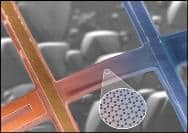The material graphene, which has a thickness of one atom, maintains its high conductivity even after it is fixed to the substrate - a necessary step in the transfer of the material from the laboratory level to the level of its utilization as a useful component in a variety of nanoelectronic devices, researchers report in the scientific journal Science.

The team of engineers and theoretical physicists from the University of Austin (Texas), Boston College and the French Atomic Energy Commission reports that an extremely thin layer of carbon atoms - taken from the three-dimensional material graphite - is able to conduct heat twice as well as thin layers of copper and fifty times better than Thin layers of silicone.
Since its discovery in 2004, the material graphene has been considered a promising material for the electronics industry thanks to its advantages: good electron mobility, mechanical strength and thermal conductivity. These characteristics are essential for electronic devices that are getting smaller and smaller, which presents engineers with the basic problem of keeping the devices at a low enough temperature to obtain efficient enough operation.
The research advances the understanding of graphene as a promising candidate for removing heat from "hot spots" that form in the tight spaces between the nanometer and micrometer electronic components found in electrical devices. From the theoretical aspect, the research team also discovered how the heat flows inside the graphene.
In suspension form, graphene has an extremely high thermal conductivity of 5000-3000 watts/meter/kelvin. However, for practical applications, the solid lattice of graphene is attached to some substrate. The research team discovered that fixed graphene still has a thermal conductivity of 600 watts/meter/kelvin, close to room temperature. This level exceeds the thermal conductivity of thin layers of copper (250 watts) and tin (10 watts), used today in electronic devices.
The loss in thermal conductivity is due to the interaction of the graphene with the substrate, which interferes with the vibrational waves of the graphene atoms when they collide with the substrate atoms, according to one of the researchers who co-authored the article, physics professor David Broido.
The conclusion also derives from previous theoretical models regarding heat conduction within free graphene (as a suspension), adds the researcher. The joint research team reexamined the theoretical model to explain the capabilities of free graphene.
"As theorists, we are much further from the engineering or physical aspect. We are more focused on understanding the basic principles that could explain how energy is transferred within a graphene sheet. We took the theoretical model for free graphene and expanded it so that it could explain the interactions that occur between the graphene atoms and the substrate atoms, the effect of these relationships on the movement of heat inside the material, and ultimately, on its electrical conductivity."
In addition to its great strength, its electron mobility and its heat conductivity, graphene is suitable for transistor devices consisting of thin layers of Zorn - a decisive feature in its ability to be used in cheap industrial production. Graphene-based nanoelectronic devices have the ability to consume less energy, function at lower temperatures, be more reliable and operate faster than the current generation of silicon- or copper-based devices.

2 תגובות
It is interesting if this material can improve the efficiency and possibly also lower the price of photovoltaic cells and thus make their use more profitable compared to oil.
It is an amazing material that is going to change the field of electronics beyond recognition. I hope they discover more materials the way they discovered this material.